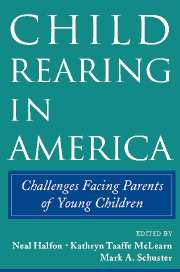Book contents
- Frontmatter
- Contents
- Tables
- Figures
- Contributors
- Acknowledgments
- 1 Introduction and Overview
- PART I CONDITIONS OF FAMILIES WITH YOUNG CHILDREN
- PART II CHILD-REARING PRACTICES
- PART III DELIVERY OF HEALTH SERVICES TO MOTHERS AND CHILDREN
- 9 Prenatal Care, Delivery, and Birth Outcomes
- 10 Access to Health Care for Young Children in the United States
- 11 Anticipatory Guidance: What Information Do Parents Receive? What Information Do They Want?
- PART IV FUTURE DIRECTIONS AND POLICY IMPLICATIONS
- Index
- References
11 - Anticipatory Guidance: What Information Do Parents Receive? What Information Do They Want?
Published online by Cambridge University Press: 15 July 2009
- Frontmatter
- Contents
- Tables
- Figures
- Contributors
- Acknowledgments
- 1 Introduction and Overview
- PART I CONDITIONS OF FAMILIES WITH YOUNG CHILDREN
- PART II CHILD-REARING PRACTICES
- PART III DELIVERY OF HEALTH SERVICES TO MOTHERS AND CHILDREN
- 9 Prenatal Care, Delivery, and Birth Outcomes
- 10 Access to Health Care for Young Children in the United States
- 11 Anticipatory Guidance: What Information Do Parents Receive? What Information Do They Want?
- PART IV FUTURE DIRECTIONS AND POLICY IMPLICATIONS
- Index
- References
Summary
Our [medical] curriculum covers a certain amount of study of the anatomy and physiology of the child about which mothers never ask us, but the information which they seek has to do with that which cannot be obtained from books, but rather is that sort of knowledge which has passed from mouth to mouth down through the centuries. Instead of asking mother or grandmother what should be done, the doctor is consulted. If her confidence is to be retained, the physician must be as familiar with the proper manner of bathing a baby as he is with the treatment of pneumonia, and he may render the baby as notable a service in one instance as in the other.
The doctor is taking the place more and more of the ‘advice offering neighbor,’ and it behooves him to be able to advise the mother correctly.
B. R. Hoobler, “The Desirability of Teaching Students Details Concerning the Care of the Normal Infant,” Transactions of the Association of American Teachers of Diseases of Children, 1917.Physicians who take care of children are often called on to provide education and counseling about child rearing. Their advice may be especially important for the parents of young children, who grow and develop rapidly and sometimes seem to change overnight. Although physicians have been playing this role for at least the last century, the medical profession has given it greater attention in recent years in response to several factors: technological advances in medicine, a growing understanding of neuroscience and child development, and evolving systems of health care delivery.
- Type
- Chapter
- Information
- Child Rearing in AmericaChallenges Facing Parents with Young Children, pp. 320 - 344Publisher: Cambridge University PressPrint publication year: 2002
References
- 5
- Cited by

